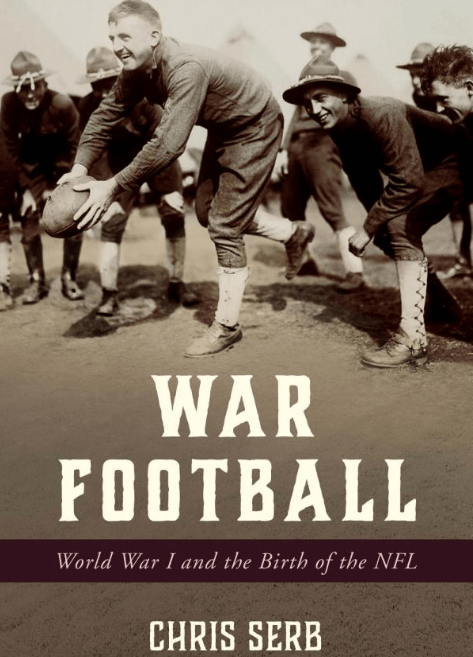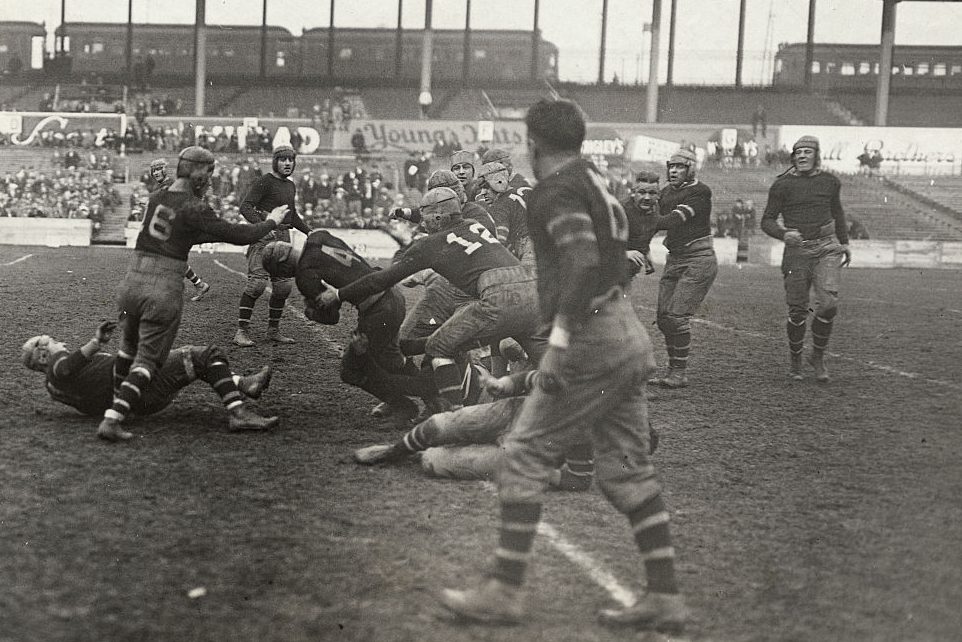Had U.S. soldiers not fought in the trenches on the battlefields of the First World War more than 100 years ago, offensive and defensive linemen may not be doing battle in the trenches of NFL game fields today.
That’s one of the major takeaways from veteran Chicago sportswriter Chris Serb’s War Football: World War I and the Birth of the NFL, an impeccably researched work which details the time period during the Great War when football was being played at U.S. military bases at home and abroad by members of the Army, Navy and the Marines.
The majority of the players who took the field in those games, which were played against other bases as well as top colleges to raise money for the war effort, had played at the college level before WWI but had little chance at going pro after their service because a respectable professional league did not exist yet.
There were some semi-pro leagues at the time, but they were looked down upon by the general public, at least partially because they took the Sabbath in vain by playing on Sundays (the only day all factory employees generally had off).
“Before the war, pro football had such a negative connotation that a lot of players played under assumed names because they did not want to be associated did not want their mom to see that they were playing for the Columbus Panhandles, or whatever the team might be, on a Sunday,” Serb tells InsideHook. “They were factory workers, regular guys who might have been good high school football players, but did not have the means to go on to college. They went out and got jobs and still enjoyed playing football and the only time they could play, because they had six-day work weeks, was on Sundays.”
Once the war began, some of these semi-pros enlisted and subsequently joined up with military football teams, mixing on rosters with experienced collegiate players who had also joined up.
Though some of the pre-war semi-pro teams may have included a few guys who were relatively big names in college, the military teams which were assembled during WWI were football’s “first true All-Star teams,” according to Serb.
“Out of 11 guys in the starting lineup, all 11 had played varsity football at a college and five or six of the 11 had been all-conference players and maybe two or three had been all-American players,” Serb says. “It really was the first time you had that kind of assemblage of star power as circumstances did not allow for that before the war. It was also democratizing, You would see=e three lowly privates and they are starting right alongside the captains and majors and in some cases pushing other captains and lieutenants onto the bench.”
These All-Star teams were able to capture the national public’s attention in ways that semi-pro squads had not been able to and, by raising millions of dollars for the war effort, proved there was a market for more than just college football.
“It showed investors that people would come, that supply will create its own demand I guess and people will come to see teams of All-Stars,” Serb says. “Even if they did not come at the rate or in the numbers that they would go to see college games in the 1920s, they showed up. It became a financially viable proposition which it really was not in the era right before war football. It showed these organizers and these investors that if you build it, they will come essentially. War football showed that, even if it is not as big of a market as college football, a market exists and we can create our own little niche within that market.”

It also showed the public that not all football players who were competing for somewhere other than Harvard or Notre Dame were unworthy of their respect.
“I definitely think it changed the perception in the public consciousness of what a professional football player was,” Serb says. “It was no longer a dropout or just some mechanic, as awful as that might sound. This guy went to the University of Illinois and this guy served with the 89th division … this guy is all right. If this is good enough for a college graduate, a military veteran, then I can support this. It definitely had a positive effect on the image of the professional football player.”
For the players themselves, playing war football made them realize that their football careers didn’t have to end after college and that they enjoyed the sport enough to keep playing were it a viable post-war option.
Chicago Bears founder, owner and original coach George Halas, one of the driving forces behind the formation of the American Professional Football Association (which became the NFL in 1922, was just one of more than 200 military veterans who played in or coached for the fledgling NFL.
“Halas is clearly the biggest name in the book, the one that echoes the most and had the most influence on the professional game,” Serb says. “Without war football, he probably would not have played pro football at all. Or if he did, he would have played at a pretty minor level. He just was not that good in college. His war football experience had a lot to do with his success in being an NFL pioneer.”
While it’s possible the NFL or another professional football league would have created at some point, the football which was played during WWI certainly helped expedite that creation by five, ten or even 15 years, according to Serb.
“That is one of the legacies of World War I,” he says. “It was a horrible, brutal, awful war, but you see a lot of scholars talking about how it led to great advancements in music, in literature and in various things like that. We have not seen a lot of scholarship or any scholarship on what it did for sports. War football did clearly and directly lead to the birth of the NFL, much sooner than it would have if we had not had a war. A lot of people thought the war was going to kill football, you know that all our football-playing men are going to be off in the trenches and not going to be here at good old Notre Dame or the University of Oregon or whatever the case might be. Really, it kind of had the opposite effect. It really jump-started a second wave of football here in America and jump-started the NFL”
The Charge will help you move better, think clearer and stay in the game longer. Subscribe to our wellness newsletter today.



















